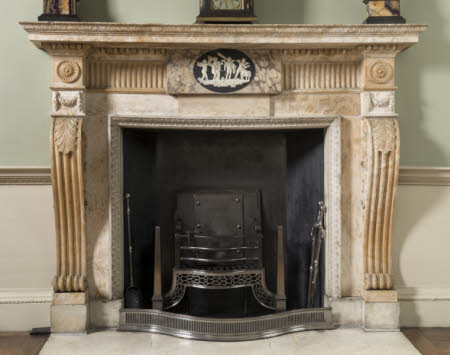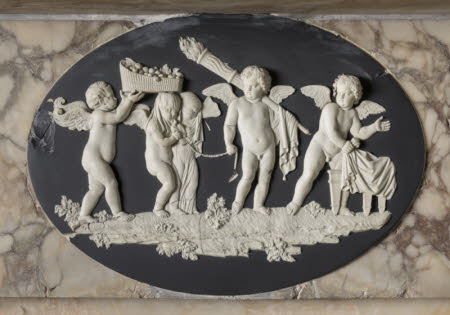The Family Corridor chimneypiece, with 'The Marriage of Cupid and Psyche'
Robert Adam (Kirkcaldy 1728 - London 1792)
Category
Architecture / Features & Decoration
Date
1761 - 1768 - circa 1785
Materials
Alabaster, marble and jasperware
Measurements
1685 x 2220 x 260 mm
Place of origin
Great Britain
Order this imageCollection
Kedleston Hall, Derbyshire
NT 107909
Summary
Alabaster, marble and jasperware, the Family Corridor chimneypiece, designed by Robert Adam (1728-92), with oval jasperware plaque by Josiah Wedgwood (1730-95), c. 1761-68, plaque c. 1785. The Family Corridor chimneypiece carved of alabaster, with moulded shelf carved with acanthus and egg and dart cornice motif. The frieze fluted, flanked by circular paterae in relief, with centralised rectangular black-veined marble panel inlaid with Wedgwood plaque. The dipped jasperware plaque with relief of the marriage of Cupid and Psyche (see 107909.2) on a dipped black background; the design after the Marlborough gem, a Roman cameo in the Museum of Fine Arts, Boston (inv.no. 99.101). Jambs surmounted with white marble blocks carved with relief festoons; volute jambs of alabaster with acanthus corbels. Moulding at aperture in white marble carved with foliate motif. The chimneypiece was designed by Robert Adam; see original design dated 1761 (NT 109900) inscribed by Nathaniel Curzon (1726-1804) 'Executed with the addition of a Wedgwood plaque in centre'.
Full description
The Family Corridor chimneypiece contains the earliest known Wedgwood jasperware inset to remain intact (Kelly 1965, p. 71). It depicts among the most popular of Wedgwood’s designs, the marriage of Cupid and Psyche adapted from the Marlborough gem (MFA, Boston, inv.no. 99.101), a celebrated Roman cameo of layered onyx owned by the Flemish painter Peter Paul Rubens and later by the Dukes of Arundel and Marlborough. Wedgwood’s interpretations of the Marlborough gem were produced in a variety of different sizes, from ring-sized cameos to plaques, and in a variety of media, from jasperware to terracotta and basalt. The Kedleston plaque was previously thought to have been sold to Nathaniel Curzon (1726-1804) during one of Josiah Wedgwood’s promotional tours of the country, where, as a travelling salesman, he would exhibit examples of his products to the British elite in the comfort of their stately homes. In September 1778 he visited Derbyshire, writing to his business partner Thomas Bentley to say: ‘…I have two or three very fine tablets with me, & an easy introduction to show them at Kedleston, for Mr Curson was at Keel when Lady Bagot fixed up a tablet and two frises…& wished Lord Scarsedale might see some of the tablets…’ (Wedgwood quoted in Kelly 1965, p. 71). Although Kedleston Hall was completed before Robert Adam could have used Wedgwood jasperware in his architectural scheme, Wedgwood's jasperware, designed in the neoclassical style, harmonised perfectly with Adam interiors. A description matching this black jasperware plaque or tablet has recently been identified in the Wedgwood factory Oven Books in 1785, and was among the earliest examples of this particularly colourway. Alice Rylance-Watson 2019
Provenance
Purchased by Nathaniel Curzon (1726-1804) c. 1761-68 as part of Robert Adam's remodelling of Kedleston; Wedgwood jasperware plaque purchased Nathaniel Curzon c. 1785 from Josiah Wedgwood (1730-95) (previously thought to have been acquired c. 1778, see Wedgwood, letter to Thomas Bentley, September 1778, quoted in Kelly 1965, p. 71); purchased with part of the contents of Kedleston with the aid of the National Heritage Memorial Fund in 1987 when the house and park were given to the National Trust by Francis Curzon, 3rd Viscount Scarsdale (1924-2000).
Credit line
Kedleston Hall, The Scarsdale Collection (acquired with the help of the National Heritage Memorial Fund and transferred to The National Trust in 1987)
Makers and roles
Robert Adam (Kirkcaldy 1728 - London 1792), architect Wedgwood, manufacturer Robert Adam (Kirkcaldy 1728 - London 1792), designer
References
Kelly 1965: Alison Kelly, Decorative Wedgwood in Architecture and Furniture, London 1965, pp. 57, 71

